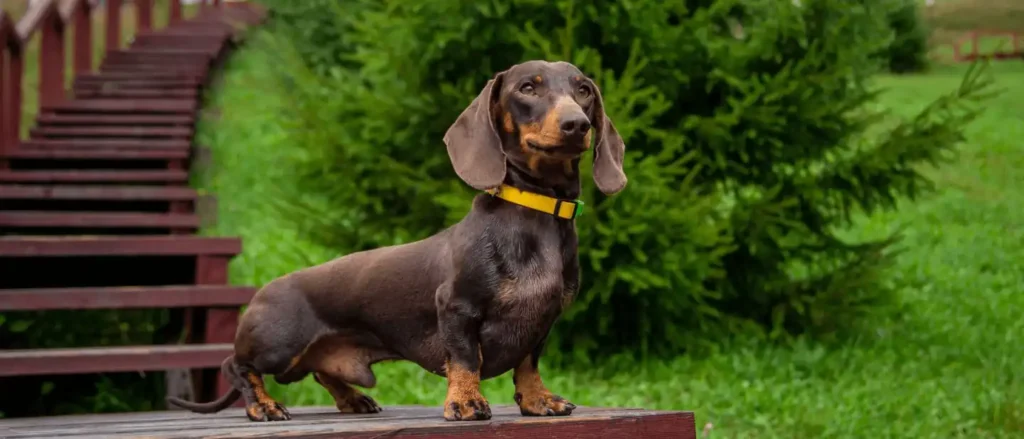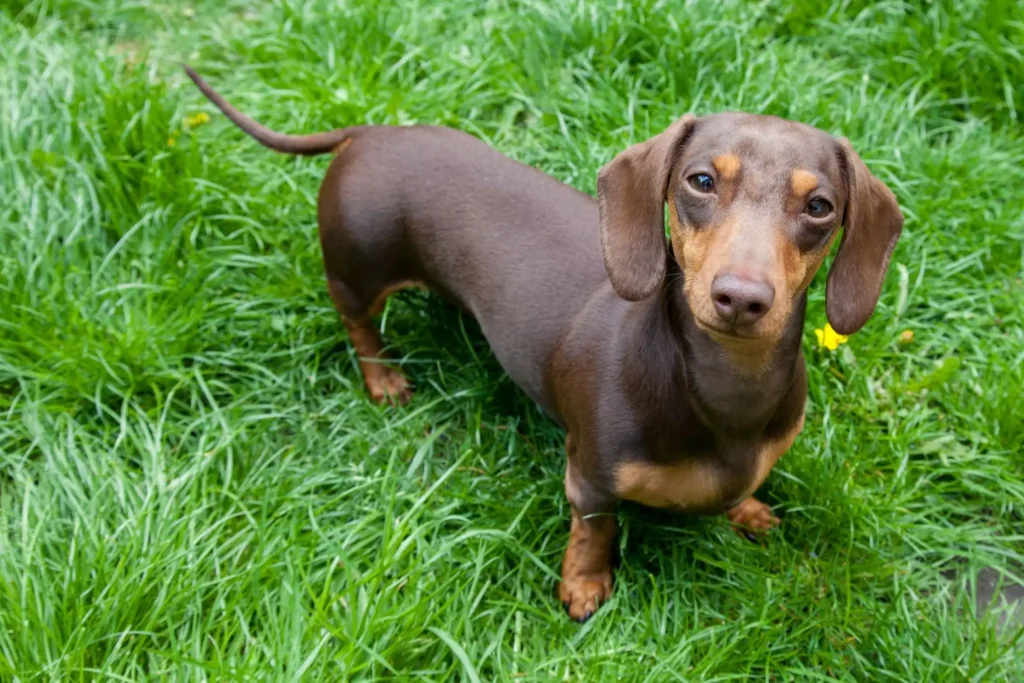Dachshunds have a very unique body shape, short legs but a long, thin body. This low-slung body shape is good at digging holes, right? Did you know they were the inspiration for the hot dog? And that they were once the mascot of the Olympic Games? Find out what their tricks are and other secrets that will surprise you!

💡1. A hound with great skills?
The Dachshund’s ancestor is the German Badger Hound, which can be traced back to the 15th century. It is a kind of short-legged hound, whose short legs can quickly enter and exit narrow caves, allowing them to go deeper into the caves to hunt their prey, and they are the hunter’s good helper, specializing in hunting badgers, foxes, rabbits, and other animals who love to drill holes in the ground. Nowadays, Dachshunds are mostly domestic dogs and are loved by many people, but they still have the nature of a hound.
💡2. It is the source of inspiration for hot dogs!
The name Dachshund, known in Germany as Dachshund, means badger dog, and because of its sausage-like shape, people began to call it simply Dachshund, or sausage dog for the older generation.
It is said that German immigrants brought a kind of sausage-like “dachshund” (dachshund) from their hometown to the United States and named the sausage bread “dachshund”, which was later simplified to “hotdog” for ease of pronunciation.
💡3. Dachshund was the Olympic mascot?

The 1972 Munich Olympics saw the first mascot in the history of the Olympics: Waldi the German Dachshund, and every Olympics since then has had a mascot, but the Dachshund was the first to become the mascot of the Olympics!
💡4.The mystery of Dachshund’s life expectancy
The average life expectancy of a Dachshund can be as long as 12 to 15 years old, and can be ranked among the top 3 in terms of longevity! In 2009, Chanel, a Dachshund residing in Long Island, United States, became the world’s longest-living dog champion at the age of 21 years old. There are also studies that show that small dogs with long noses, such as Dachshunds, can live longer than large, flat-faced dogs such as English Bulldogs.
(Reference: https: //www.jagger-lewis.com/en/blogs/dogs-breed-that-leave-the-longest)
💡5. Digging is natural?
If you have a Dachshund at home, you will probably find that they love to dig!
Dachshunds by nature are good at drilling or digging holes, deep into the enemy camp hunting, even if not when the hound has been many years, but still the habit does not change, at home to see the cracks in the sofa can not help but dig, so they demolition of the home is very much a Dachshund style, but the sofa has been destroyed in the home is really hurtful!
How to stop a Dachshund from digging at home
- Smell the prey:
- Are there other small animals in the house? We recommend that you keep your couch and other corners of your home clean so that uninvited guests don’t come in and dig a big hole in your home just as your dog takes it as prey.
- Store food:
- Some dogs will dig holes and hide some of their food to enjoy, so it’s a good idea to feed them regularly or put them in a fixed place such as a cage, so they know they don’t need to hide their food and that no one is going to steal it from them.
- Release stress:
- When he is a bit anxious or bored, he may dig holes to release his stress. Give him some toys and set aside time to take him out every day to play.
💡6.Dachshund’s coat color and health

Dachshunds can be categorized into three types: short-haired, bristly and long-haired. There are many coat colors, the more common ones are: black, chocolate, red, cream, gold, etc. Some Dachshunds have different color patterns or spots on their bodies.
The relationship between coat color and health
The different coat colors of Dachshunds often harbor different genes for genetic diseases, so if Dachshunds are randomly matched, they may give birth to puppies with genetic diseases.
For example, a cream-colored Dachshund with insufficient melanin and weak skin resistance is best mated to a black and brown Dachshund or a tiger-dapple Dachshund to avoid passing on melanin deficiencies to the next generation.
💡7. Dachshund’s Exercise Requirement
How much exercise does a Dachshund need?
Dachshunds are strong and energetic, and can be regarded as an electric motor. It is recommended to run and walk twice a day, but do not jog for a long period of time, especially the standard long-haired Dachshund is not suitable for running for a long period of time.
Exercises for Dachshunds
Dachshunds are always energetic outdoors because they are originally hounds, but it is important to note that any exercise that will increase the burden on the spine is not suitable, such as climbing mountains, stairs, jumping, or overly intense exercise should be avoided, and is suitable for walking, running or swimming, and it is recommended that after 15 minutes of exercise, you should allow them to take a 10-minute break before proceeding to the next round.
💡8. Dachshund’s Characteristics
Dachshund’s character: Smart, independent, stubborn?
They are lively and affectionate, and are good companions for human beings. Although they love digging holes by nature and are often the king of destruction in the house, how can you bear to be angry with them? However, they are actually slow to warm up, and are more alert to strangers, and may bark at people they don’t know well or be more distant.
Different breeds of Dachshunds also have subtle differences in personality. Long-haired Dachshunds are said to be more calm than short-haired Dachshunds, while Dachshunds, which are less common in Taiwan, are more outgoing and active. In addition, although they are small in size, they are courageous and bold, and they are not afraid of animals much larger than themselves and will even provoke them, giving the impression that they have a tendency to be aggressive. Dachshunds can be very well-behaved as long as they are properly trained.
How to Train a Dachshund
Training a Dachshund is not difficult, but the key is patience. Since they are emotional, if you are not gentle, you will not be able to motivate them to accept the training. If you force your puppy into training right after you bring him home, he may feel threatened and show destructive behavior. It is advisable to leave them alone in a space for a few days to allow them to feel secure in their environment, then familiarize them with the rest of the house before starting training.
The ideal age to train a Dachshund puppy is 8 to 12 weeks, which is when the puppy is weaned and ready to move on to adulthood. Dachshunds will want to chew on shoes, books and furniture. This destructive behavior is in their nature, so instead of being stern, gently and firmly tell them “no” and take the item out of their hands, and make sure you do this while they are chewing. If you wait until they have finished chewing, they will not understand that you are correcting their behavior. Give them chew toys to help satisfy the urge to chew. Praise your Dachshund when he chews on a toy so he knows he is doing something right. Physically or verbally scolding your dog will only frighten him and make the training process more difficult.
💡9. Dietary Taboos for Dachshunds
Dachshunds need to strengthen their diet in the following areas:
- Promote muscle development: As they are active, they need high quality proteins to promote muscle development. High quality proteins help to reduce the amount of bowel movements and odor in Dachshunds.
- Bone and joint health: Choosing a formula designed with the right amount of calcium and phosphorus can help maintain healthy bones and joints in your Dachshund.
- Maintain ideal body weight: A balanced diet with appropriate vitamins and minerals is essential to help maintain a healthy gut and good body condition.
💡10. Dachshund Health Problems
Dachshunds have some inherited diseases that require special attention:
- Spine: Dachshunds are particularly susceptible to spinal problems due to their low-chassis stature, the following are some suggestions for caring for them:
- Don’t let him walk up stairs or jump up and down.
- Hold the Dachshund with one hand around the chest and the other hand on the buttocks.
- Take regular nutritional supplements for joints.
- Pay attention to keep fit, obesity will cause burden on the spine and knees.
- Eyes: Hereditary retinal degeneration is also a common problem in dachshunds. Feed spinach, pumpkin, blueberries, or vitamin C, anthocyanins, lutein, and other nutritional supplements.
- Ears: Since Dachshunds have pendant ears, the ear canals are prone to harbor dirt and bacteria that can cause ear infections over time. It is recommended to blow-dry the ears after bathing, and avoid using cotton swabs to clean the ears as they may push ear dirt deeper into the ear canal, instead, use a pet-specific ear cleaner with cotton.
- Heart: Small dogs are prone to heart problems, so remember to give your veterinarian a checkup every year and supplement with fish oil and other nutrients to help maintain your dog’s cardiovascular health.
💡Conclusion
The Dachshund is a lively, curious beagle, although small in size, their bravery and loyalty make them a good companion for many families, if you can pay enough patience and love, they can fill your life with endless joy and beauty.
